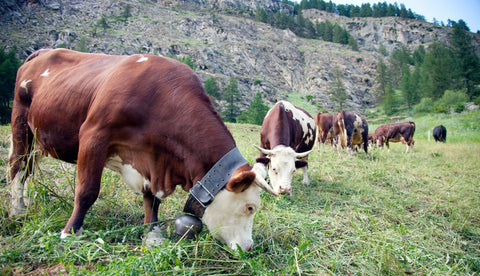My shopping cart
Your cart is currently empty.
Continue Shopping.
The earliest written evidence of bells worn by livestock in Europe dates to the late 1300’s. In Germany at the time, a bell was first worn by only the most valuable cows in the herd. As time went on, farmers began to see the benefit in hearing not only where the livestock were, but the age or value of the cow by using differently tuned bells, based on their size. The larger the cow, the bigger the bell! And so, the majority of the heard wore cow bells during the warmer seasons while they were free to roam the Alps.
A very large bell has the deepest sound and was usually reserved for the lead cow. The use of cow bells for cattle also had other advantages, as the clatter of many bells warned off predators.

Every year during Autumn, all the livestock return from the high meadows to prepare for the colder months. This is referred to as Alpabzug. The best cows from each herd, also called Kranzkuh (Crowned Cow) lead the procession and are adorned with vibrant ornamental headwear. This traditional festival in Southern Germany in is known as Viehscheid or Almabtrieb, though has other names throughout the Alpine regions.
These traditions have been ongoing now for almost three hundred years, as the earliest of these festivals with decorated cows date back to the mid-18th century in Tyrol, Austria. Today, an Almabtrieb is one of the most unique cultural experiences in Germany to be a part of.

These days, the cow bell is an iconic symbol of the Alpine region and while still worn by cattle, has become a popular decorative piece for around the home or in a smaller form, a shiny accessory!
Cow bells will also make their appearance during sporting festivals throughout Europe and even Australia. Their loud clear notes, in many different octaves are the perfect "noise maker" to cheer on athletes. If you look closely during the Tour De France bystanders are often seen ringing these bells.
There are also traditional tuned cow bells (Alpenglocken), which are used as a musical instrument and typically come in one-octave sets, consisting of 13 differently tuned and sized bells.
Our cow bells range from adorable 2.5cm keyring accessories to authentic and rustic 23cm cow bells (bell width without the strap) with a traditional leather strap suitable for a large cow, and every size in between!
See our collection of Cow bells